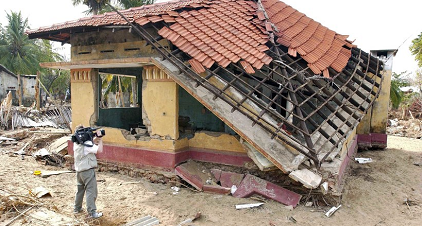
A cameraman films some of the destruction caused by the tsunami of 26 December 2004 in Mullaitivu, a town in northeastern Sri Lanka. The tsunami claimed the lives of thousands of members of this community (UN Photo/Evan Schneider)
By Robert Glasser
Over the last week I have moderated discussions in Geneva and New York in which representatives from tsunami-exposed countries including Chile, Indonesia, Japan and Maldives have shared their recent experiences of this rare but most deadly of disasters.
This has provided me with a keen insight into the challenges around this natural hazard which, down through the ages, has taught us many hard lessons about the thin margin between life and death in many exposed parts of the world including countries bounding the Pacific, the Indian Ocean, the Atlantic, the Mediterranean and its connecting seas.
It is sobering to be reminded that 80% of the Maldives is just one metre above sea level and that the country abandoned 13 islands following the devastation wreaked by the Indian Ocean tsunami in 2004.
At the same time, it has been heartening to hear about the improvements in disaster preparedness and disaster risk management which have taken place in all these countries as a result of past tragedies.
In Indonesia, disaster risk reduction is a major pillar of the country’s development strategy. The Indian Ocean tsunami warning system installed following the 2004 tsunami ensured that warnings were issued within five minutes of an 8.6 earthquake being felt in Banda Aceh on April 11, 2012; ensuing events demonstrated the importance of holding drills and educating the population on evacuation procedures.
Chile took legal action against officials following confusion over issuing early warnings following the February 2010 earthquake and tsunami and has since put in place much tighter coordination with broadcast media and other key stakeholders to ensure there is no repetition.